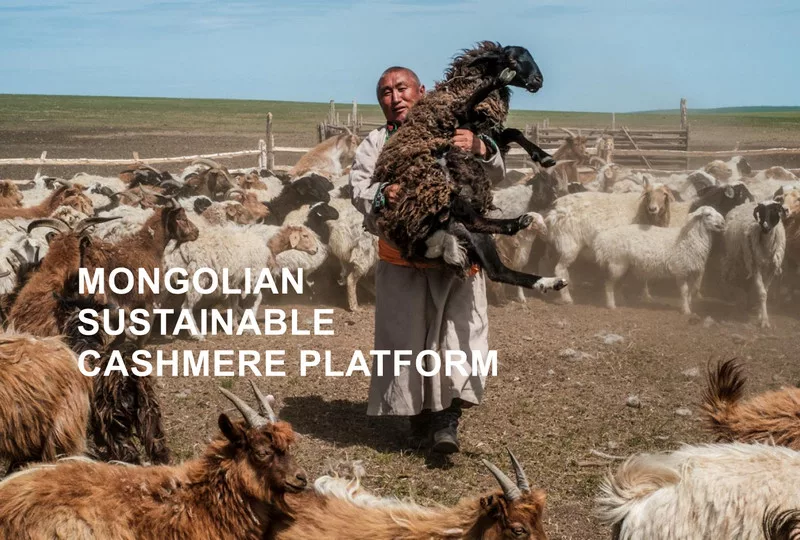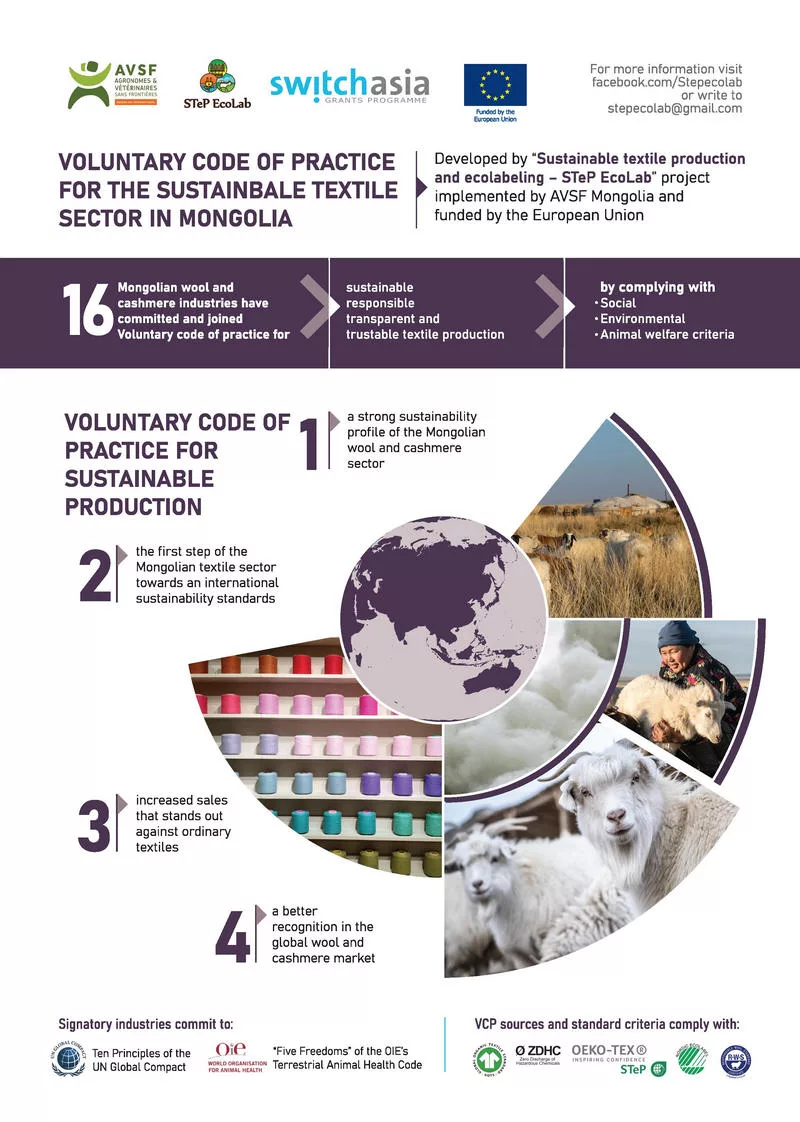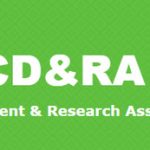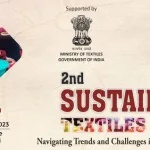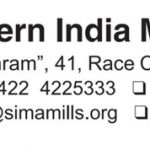“Roadmap for the Sustainable Development of the Mongolian Cashmere Sector 2030”
|
Cashmere is a multi-billion dollar commodity and recent increases in demand have led to the degradation of grassland and desert steppe ecosystems in East and Central Asia. Cashmere wool is a product of goats and 90% of the world’s supply originates from Mongolia and northern China. As global demand for cashmere increases, the consequences to the natural landscapes and people of the region may be severe, especially given the rapid rate of environmental change due to warming climatic conditions in the region.
Textile manufacturers recognize the need for better goat herding practices and support the development of a sustainable cashmere certification program. While simple in concept, sustainable certification requires a clear set of goals and measurable attributes that define the various dimensions of sustainability. Any certification program also needs to account for ongoing landscape changes due to factors like climate change, infrastructure development, and livestock grazing. In Mongolia, several nonprofits, industry representatives, government officials, and herders have formed partnerships in separate areas of the country to develop systems for sustainable cashmere production. However, these projects are mostly operating independently from one another and there is no consensus among these groups about what sustainable cashmere livestock management actually entails.
Sustainability efforts focus on creating a certification program in which higher cashmere prices will be paid to herders that adopt sustainable practices that reduce impacts on the environment while also improving animal welfare and health.
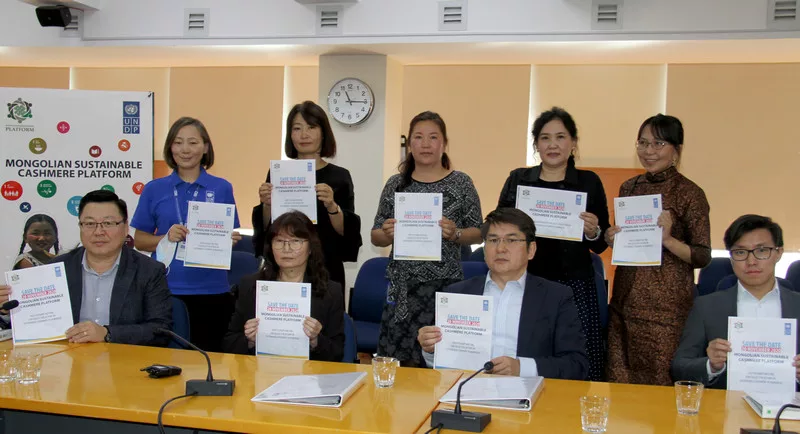
The Mongolian Sustainable Cashmere Platform was established at UNDP Mongolia. Steering Committee Members of the Platform are seen here (18 September 2020)
A study titled “Comparative Analysis Of Sustainable Cashmere Projects In Mongolia” – funded by UNDP – has several interesting findings. There are different institutions operating projects in Mongolia with sustainable cashmere as a stated project output: Asian Development Bank (ADB), Agronomists and Veterinarians Without Borders (AVSF), Swiss Development Corporation (SDC), Sustainable Fibre Alliance (SFA), United Nations Development Program (UNDP), Wildlife Conservation Society (WCS). Each organization operates their own regional programs throughout the country, with many of their project areas overlapping, and takes a different approach depending on their expertise and goals. Brand representatives tend to be focused on traceability and ensuring cashmere can be verified as being sustainably raised. WCS is focused on minimizing impact to the environment and animals. ACSF and Green Gold focus more on livestock health and capacity building. The UNDP Mongolia has undergone serious efforts in recent years to consolidate these sustainable cashmere efforts and encourage collaboration between groups. The Sustainable Fibre Alliance is another organization working to create a unifying umbrella within which groups can operate.
|
Some issues with these efforts thus far are that there is a lack of consensus on what sustainable cashmere management entails and how to measure it. Several of the groups have significant monitoring programs in place, but most focus on vegetation and rangeland health, without considering other important intersecting ecological components, such as wildlife. For the most part, approaches by these groups have looked at ecological and social/economic factors separately. True sustainable management needs to include ecological, social, and economic components. Management efforts also need to be able to adapt to new information (e.g., from ongoing monitoring) and changing conditions over time — something that is not incorporated explicitly into many cashmere programs.
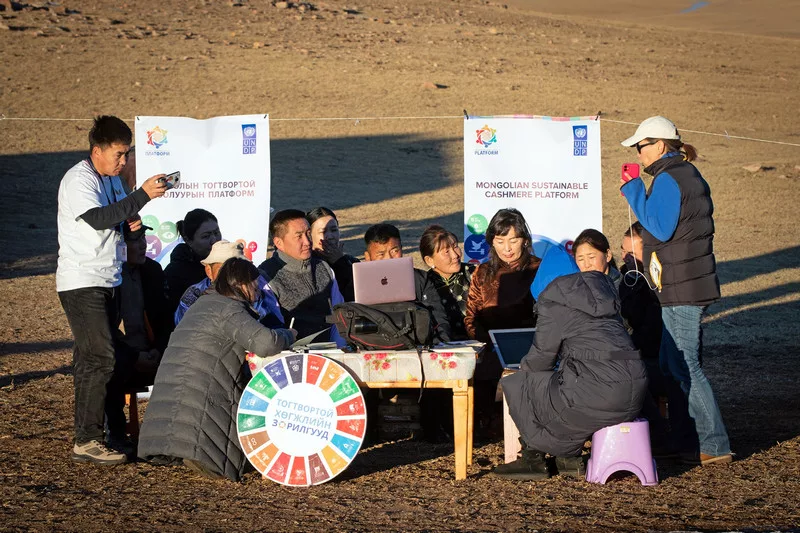
The world-renowned luxury cashmere brands including Hugo Boss, Kering group, Burberry and Schneider, had a series of virtual meetings with Mongolian herders from 19-23 October 2020. The Mongolian Sustainable Cashmere Platform at UNDP Mongolia co-ordinated these meetings.
By the initiative of the European Union funded “Sustainable Textile Production and Ecolabelling project (STePEcoLab)”, the “Roadmap for the Sustainable Development of the Mongolian Cashmere Sector – 2030” has been developed in collaboration with relevant ministries, agencies, professional associations and experts. As a result, the government policies and programs, international assistance, and consumer needs and demands have been harmoniously planned, and stakeholders have defined a common vision and a clear path to achieve it. The roadmap supports environmentally friendly production at all stages of value chain – starting from the preparation and supply of raw materials at herder level and promote sustainable consumption until the end of the line.
During the Roadmap launch event, J. Bat-Erdene, Member of Parliament and President of the Mongolian Wool and Cashmere Association (MWCA), emphasized “The wool and cashmere sector, with more than 10,000 employees and 400 million USD in sales, takes the second place after the mining sector by the contribution to the development of the country. The “Roadmap for the Sustainable Development of the Mongolian Cashmere Sector 2030” is the first “sustainable development” document in the light industry sector. The particular importance of this roadmap is the definition of the vision, mission and medium and short-term goals and objectives for the environmentally friendly and sustainable development of the Mongolian wool and cashmere industry until 2030. Representatives of international projects and programs, public and private sectors and professional associations were actively involved in the development of the roadmap, and the MWCA will undoubtedly play a role of a leader and initiator in the implementation of its’ activities in the sector.” in his speech.
H.E Ms Axelle Nicaise, Ambassador of the European Union to Mongolia: “Mongolian cashmere is a unique product and is important not only for the livelihood of herders, but also for the economy and value chain of the country. On the other hand, cashmere production has an impact on the environment. Therefore, we must focus on sustainable cashmere production, with quality over quantity to achieve more with less. If we do not take action now, natural resource will further degrade and pasture deterioration will worsen. The adoption of this ‘Roadmap for the Sustainable Development of the Mongolian Cashmere Sector 2030’ will be an important impetus for environmental protection. Mongolia is a beneficiary of the GSP+, the EU’s preferential trade scheme through which certain products can be exported to the EU-market tariff-free. The textile sector is currently the largest beneficiary of the trade scheme. We are currently in the process of negotiating Geographical Indications (GI) for a comprehensive list of products from Mongolia, among which cashmere is on the top of the list. ‘Uvs Chatsargana’ seabuckthorn berries from Uvs aimag, have been registered in the EU as the first Protected GI from Mongolia. PGI can bring the advantage of increasing the income of local producers, supporting sustainable business, preserving the uniqueness and quality due to the environment and climate, creating new opportunities, opening bigger markets and ensuring customers’ use of quality and standard products. The GI is a socially, environmentally and geographically important indicator. We hope that the beneficiaries of the project will continue to gain from our efforts going forward.”
Mr. G. Batsuuri, Deputy Minister of the MoFALI: “At a time when global consumers value “environmentally friendly and sustainable production-consumption” due to the global warming and climate change, one step towards making wool and cashmere sector of Mongolia a priority has been taken. Within the framework of the EU-funded “Sustainable Textile Production and Ecolabelling project (StePEcoLab)”, a “Roadmap for the Sustainable Development of the Mongolian Cashmere Sector 2030” has been developed. This roadmap identifies where, when, and how each stakeholder in the sector can contribute to better coordination of the Mongolian wool and cashmere industry by 2030. It is a key document for the activities in conformity with the government policies and strategies in the field of agriculture and animal husbandry, and cooperation between herders, producers, research and government organizations, professional associations and international projects and programs.” Mrs. D. Altantsetseg, Executive Director, Mongolian Wool and Cashmere Association: “In recent years, consumers have tended to buy environmentally friendly and sustainable products. Therefore, we will be fully able to compete in the world market, if we set the main criteria that Mongolian cashmere is of the highest quality, environmentally friendly and sustainable. Mongolian cashmere products are exported to 30 countries around the world. As a result, sales of one trillion and 200 billion MNT were made.
Dr. Ts. Enkh-Amgalan, Chairwoman, National Federation of Pasture Users’ Groups: Climate change and consumer trends in any industry require a clear and intelligent production system that is environmentally friendly, healthy and safe for the human being, and has a traceability system. In this context, having a roadmap for the Sustainable Development of the Cashmere Sector means Mongolia has been renewing its strategy to bring its cashmere production to the world market. Previously, our country was known as a supplier of raw materials to the international market, but now we guarantee distinctive features of the final products.
Sustainable Textile Production and Ecolabelling project (STePEcoLab): The STeP EcoLab project, funded by the European Union and implemented by AVSF, aims at supporting the supply chain and the textile industry in adopting more sustainable sourcing and production practices and simultaneously improving the branding for sustainable products, optimising cost-saving measures and reaching out to climate finance and diversify the portfolio of customers. STeP EcoLab strives to leverage key drivers of sustainable consumption and production in Mongolia by consolidating sustainable and certified raw material sourcing options meeting markets expectations; developing a conducive environment for textile processing SMEs to switch to sustainable production practices; and raising customers’ and consumers’ awareness of Mongolian sustainable textile related initiatives.
Also Read
Top Mongolian Producers of Cashmere
Statement of Francesco Saldarini, a Partner of the Mongolian
National Federation of Pasture User Groups (MNFPUG) Union
